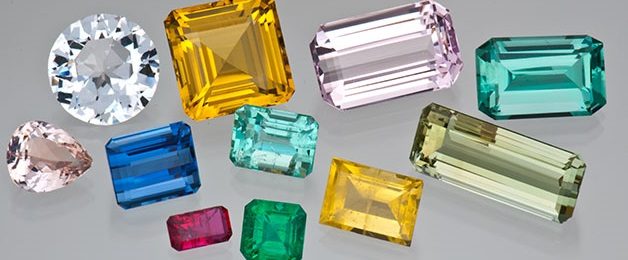I love visiting London. This time my visit included a trip to the “Natural History Museum” to see the most fabulous collection of colourful Diamonds in the world, which is hosted in the museum’s ‘mineral’ section. We are talking about the “Aurora Pyramid of Hope”. If you take the time to walk through the museum’s mineral collection, you will find not only the “Aurora Pyramid Of Hope ” but many other wonders that will leave you breathless. For example, a wonderful necklace adorned with Black Opals, the side of the necklace features four huge, cut and polished, black opals with dazzling opalescence. Seeing them you cannot help thinking that these stones are magic!
Speaking of magic, a few meters away a pendant featuring a huge Amethyst is displayed, the “Delhi Purple Amethyst”, famous during the nineteenth century. This gem was looted from the Temple of Indra during the horrific Indian Mutiny of 1857. Each of its subsequent owners have suffered mishaps and misfortunes.
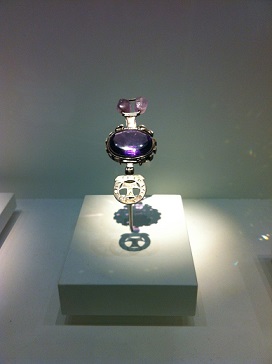
Amethyst Pendant featuring the “Delhi Purple Amethyst”
If you dare, you can have a close look at the “Cursed Amethyst”, donated by the daughter of Edward Heron-Allen, an English polymath, scientist, Persian scholar and close friend of Oscar Wilde. Heron-Allen was the stones last owner in 1890, and he was convinced that the jewel was “cursed and bloodstained”. After many recorded and personal mishaps he had it locked away in a bank vault, with specific instructions not to open it until 3 years after his death. Heron-Allen’s daughter donated the stone to the London Museum of Natural History, with her father’s type written letter, explaining the history of the jewel and warning of possible dangers of interacting with the object.
Another wonder found in the Museum’s collection is a huge Watermelon Tourmaline, a rare gemstone, coveted by collectors because of its distinct colours; green, purple, pink and white. This peculiar phenomenon is present in some gemstones, where oxidation causes the presence of several colours in one stone, it is is 100 % natural.
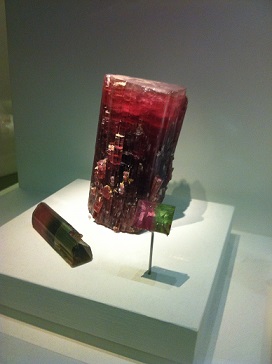
Watermelon Tourmaline
Displayed in the museums “vault” is the largest ever cut Topaz, 2,982 carats-from Brazil, as well as some beautiful Victorian jewellery in gold and chrysoberyl, necklaces with large beads of Amber and some examples of jewellery with Afghanistan Lapis Lazuli. The gems pictured were extracted from Afghanistan, 6000 years ago! Afghanistan remains the most important source of Lapis Lazuli in the world.
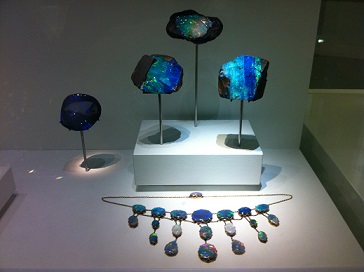
Lapis Lazuli from Afghanistan
I went to the museum specifically to see the largest collection of colourful Diamonds in the world. The pyramid shaped display has 295 natural coloured diamonds. Only one in 10,000 diamonds has a colourful variation. The colour is due to tiny particles that have been introduced into the carbon structure, or due to defects within the structure itself. In the case of “Aurora Pyramid of Hope” these pieces of diamonds display the full spectrum of colours available in the colour diamond world, including the extremely rare red diamond. This collection has toured the world as a guest of honour at some of the most prestigious museums, from Japan to Australia, including the Smithsonian Institution in Washington and the American Museum of Natural History in New York. I have wanted to see the collection for a little over 20 years but the location never quite made it. Since 2005 the collection has been exhibited in the Natural History Museum in London and finally I was able see it.
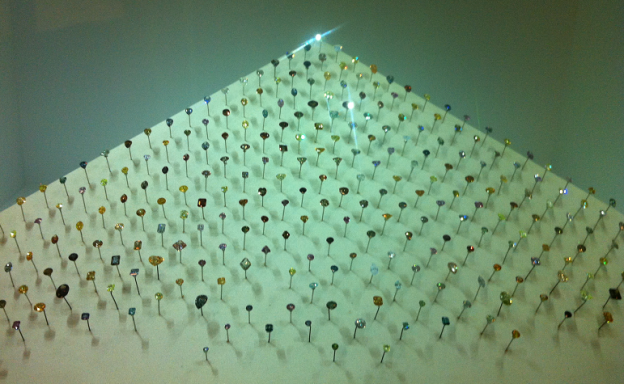
Aurora Pyramid of Hope
This “Pyramid” is the product of the tenacity and passion of two gemstone professionals: Alan Bronstein and Harry Rodman. Alan Bronstein describes the collection: “My partner Harry Rodman and I patiently selected the diamonds for the Aurora Pyramid of Hope as a model, based on the spectrum of natural colour diamonds. We wanted to have as many pieces as we could, in different sizes, varieties and colour saturation. The selection of the pieces in our collection was not influenced by the classic gemstone criteria of weight, shape or freedom of inclusions.” The basic premise of our collection is that all the colourful diamonds are the best examples of what geology offers in nature. Each of the Diamonds in the “Pyramid” has a particular story of how they came to us but what really counts is that today we have a comprehensive collection. The collection had been built over a course of twenty-five years and includes two colour changing diamonds.
Two of my London friends came along with me to the museum. Upon leaving we sat in a typical pub. To my surprise, my friends could not talk about anything but the fabulous diamonds and other wonderful gems and jewellery found in the Museum collection. The passion for gemstones is definitely contagious!
Discover our incredible selection of Diamond jewellery at Rocks & Co. >

